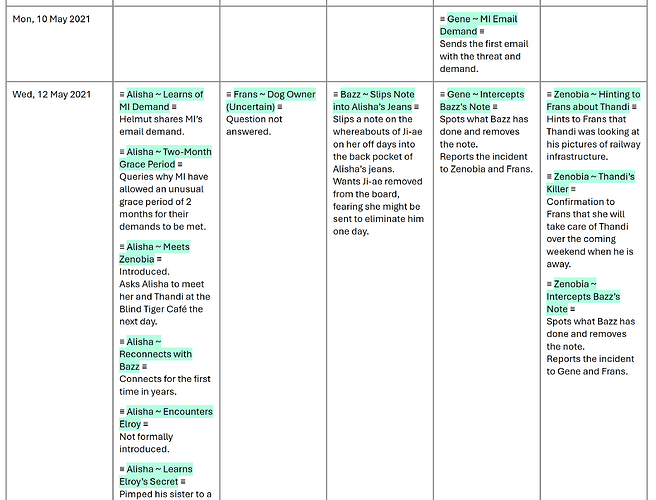Hi,
wanted to say, in general i do love the Program, and just recently bought it after a trial period. Prior i used a Word and Excel. So i am used to organize my notes in Tables. And as i now have started to convert my notes to the program and such, after i was sure to use Scrivener and bought a License, i find myself a little annoyed with the lack of ability to do Tables.
They are such a great way to organize things for fiction novels. It doesn’t really effect the actual novel writing, but for my notes i like to have… let’s say a table that keeps track of all the Military Ranks, as i am writing a Military Novel.
So my notes on that, for example, is having these Ranks in the table based on Hiarchy. Keeping a space for what their ranks compare to. For example, i have an entry for Argbed. Argbed is a military rank comparable to a castellan in the persian army around the 2nd century. And then next to that, it would say exactly that in the “notes Column” and then next to that, i have a column that lists characters with this rank. Finally, there is the column where i put in links to websites i found, in the case of the Argbed for example a link to Wikipedia.
But i quickly noticed that I can’t resize the table easily. It is not really a deal breaker, but close to it. I really wish you guys would add an excel file type to the program, so we can organize notes like that. I tried adding the .xlsx, i also converted it into a .tsv… neither seems to work. It tells me that its gonna be converted into .rtf and i figured that maybe the tab spaced convertion would work, but it doesn’t. (I mean, not that i imagined it to be legible).
I can copy&paste the tables, but then there is the issue with resizing the table in the txt document. It doesn’t work the way i’d expect it, by drag and drop the table width. And via a youtube video i found out that i can enter a percentage (it doesn’t seem to be on every table, some have a percentage other have a regular number) and it will give me some control of the resized table.
Maybe there is a workaround and i haven’t found it. I searched google for a way to reize the column and some things people suggested don’t work (if they ever did) in the current version… and others, like a video tutorial by an older lady got me the percentage resize solution.
And i get that i am new, and maybe i am just blind to the option just yet. But regardless i figured it might prove to be useful to have a new user perspective on this and the fact that i do use tables to organize some of my notes for Novels and the way its organized doesn’t seem intuitive to me, inside the program, if its possible at all (and i don’t think it is).
Anyway, thank you for reading this far, if you did.
